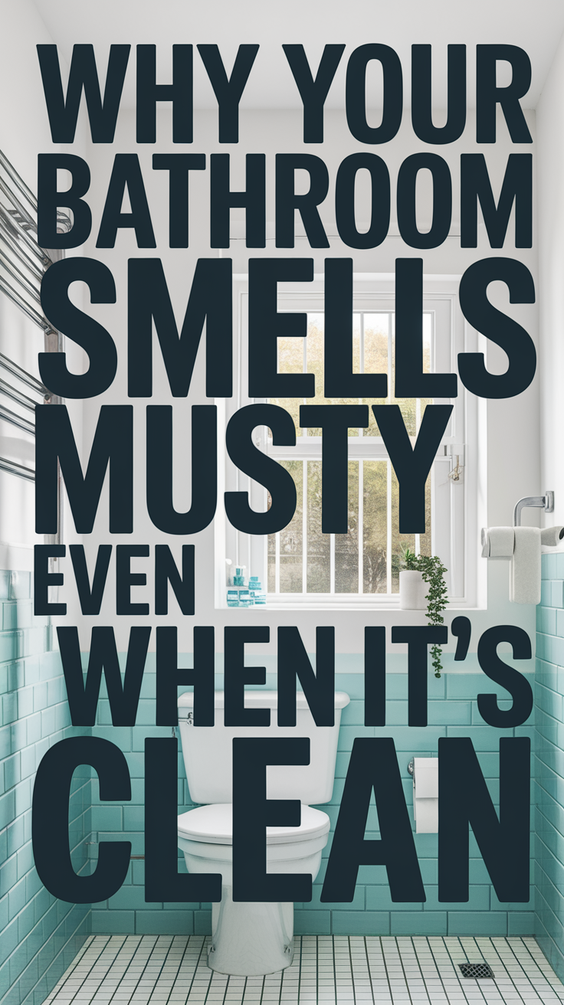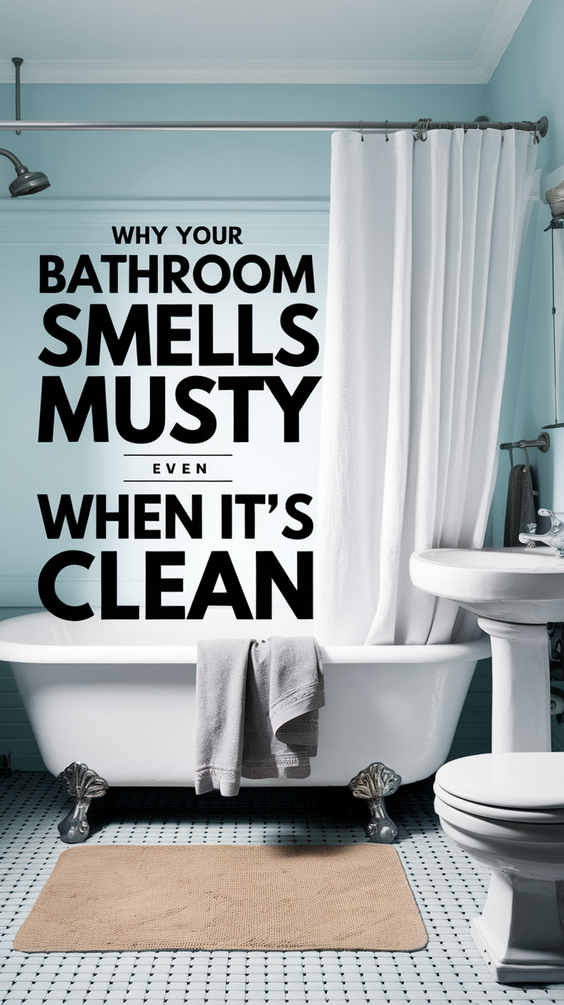Why Your Bathroom Smells Musty Even When It’s Clean

Did you wash the bathroom clean, only to be met with that all-too-familiar odor? You’re not alone. Homeowners across the U.S, even in 2025, still struggle to keep their bathrooms smelling fresh regardless of how deep they scrub. The frustrating reality is that a bathroom appearing spotless doesn’t mean it’s free from hidden issues, and fresh doesn’t necessarily mean free of odors.
In this article, you will learn about the fundamental reasons foul smells tend to persist, what is modernly responsible for them, and how to effectively eliminate them for good. These strategies are helpful for everyone: renters, homeowners, and even professional cleaners.
Who should read this? If you want to stop battling stubborn musty bathroom odors, if you want to protect your family from hidden mold, or if you want to clean your house properly, you will find helpful answers here. Let’s solve the mystery and get started.
Why Musty Bathroom Smells Are Still a Problem in 2025
Bathroom odor problems are still relevant in today’s society. Bathrooms retain musty odors due to the modern construction of eco-friendly tightly sealed homes, new building materials, excess humidity, and the prevalent ongoing war on moisture. In many cases, the rise of eco-friendly construction creates bathrooms that are even less “breathable,” capturing moisture and providing perfect conditions for bathtubs of unpleasant smells.
Increases in modern innovations means that the recommended humidity levels for bathrooms, set at 60%, are often surpassed. Combined with smaller windows and powerful showers, this explains the ever-rising need for cleaning tools in bathrooms. Is this something that concerns you? If yes, then rest assured, you’re in good company.
How We Identified the Real Causes of Musty Bathroom Odors
Identifying a problem requires figuring out its root cause first. Experts combine simple checks and modern technology when dealing with musty odor issues in bathrooms.
For any case, one always checks as the first action: stains, drying paint, mold on grout in tiles, and more. But in 2025, you can also utilize inexpensive moisture meters and advanced humidity sensors to identify problem areas before they spiral out of control.
Key Criteria for Finding Odor Sources
- Where is the smell strongest?
- Are there any visible stains or moisture spots?
- Is there condensation after a shower?
- Does your bathroom dry out quickly after use?
These simple questions can save you hours of trial and error. In fact, missing just one hidden patch of mold behind your vanity could keep that musty smell lingering for months.
What Factors Cause Persistent Musty Smells?
Recent surveys reveal the most common contributors:
- 68% of homeowners found hidden leaks as the culprit.
- 59% reported poor ventilation systems or blocked vents.
- 46% discovered black mold behind tile or under flooring.
Are you starting to see a pattern? Often, it’s what you can’t see that’s sabotaging your best cleaning efforts.
Top 7 Reasons Why Your Bathroom Still Smells Musty After Cleaning
Let’s break down the most common causes behind stubborn bathroom odors. Which one sounds familiar to you?
1. Hidden Moisture Under Tiles, Grout, and Fixtures
Water can pool around pipes or seap under the tiles which may give the illusion of a dry bathroom. This undetected moisture provides sustenance to hidden mold and mildew.
While cleaning, check the corners and borders with your palm. If you sense cool dampness, congratulations, you have discovered the main culprit.
2. Mold Growing in Hard-to-Reach Places
Mold is fond of warmth, moisture, and a dark place. Hence, even the cleanest-looking shower can conceal colonies behind the walls and under the tub.
You may see a slight green hue, some small black spots, or perhaps, a smell that just will not go away. Relying on minimal maintenance, mold can easily flourish by being given the slightest amount of attention.
3. Ineffective or Blocked Ventilation Systems
Does your bathroom fan sound like it runs infrequently or not at all? Ineffective airflow retention causes dampness which leads to musty odors.
Ensure there is no dust build-up on the fan, check if it has any suction, and confirm that the ducts are not obstructed. With the advancement of technology in 2025, upgrading to a smart exhaust fan can work wonders.
4. Outdated or Damaged Plumbing Fixtures
Old or leaky plumbing—think worn-out traps, loose washers, or cracked seals—lets sewer gases or standing water linger.
These odors can travel up from the drains, especially if you notice a “rotten egg” or sewage scent after using the sink or shower.
5. Issues With Drains and Traps
If water sits too long in the pipes, it can breed bacteria and mildew. Blocked or infrequently used drains are often to blame.
A quick sniff test near the floor or under-sink pipes can tell you if your drains need attention.
6. Renovation or Design Mistakes
Did you recently update your home? Water leakage, neglectfully sealed tiles, or grout with too little sealing can often capture moisture where it is most concealed.
Poor quality materials or hasty installations result in issues appearing years after renovations have occurred. How long has it been since you last checked your caulking and grout lines?
7. Constant Condensation on Pipes and Walls
Steamy showers create condensation, especially in winter. This water drips onto pipes and behind cabinets, encouraging mildew.
You might see beads of water even hours after a shower, signaling a need for better insulation or airflow.
Quick Checklist: How to Diagnose the Source of Musty Odors
Want to find the real problem fast? Use this checklist during your next bathroom cleaning:
Symptom – Possible Cause – What To Check
- Dampness in corners – Leaks, hidden moisture – Tiles, baseboards, under sinks
- Black or green stains – Mold, mildew – Grout, behind furniture
- Foggy mirrors long-term – Poor ventilation – Exhaust fan, window seals
- Gurgling drains – Plumbing or drain issues – Pipes, floor drains
- Odor after cleaning – Hidden moisture, sewer gas – Drains, tile seams, fixtures
Did you notice any of these signs? If so, that’s where you should start your investigation. Have you found your trouble spot yet?
Effective Ways to Eliminate Musty Bathroom Odors in 2025
The good news: most bathroom odors have a solution. Here’s what actually works today—forget the old myths.
Deep Cleaning and Disinfection: Step-by-Step
- Remove all loose items: Towels, mats, and toiletries can trap moisture.
- Clean with a mold-killing solution: Use EPA-registered products—vinegar alone won’t cut it.
- Scrub grout and tile seams thoroughly: Pay special attention to corners and behind fixtures.
- Let surfaces dry completely: Use a fan or open window to speed up drying.
- Check drains and pipes: Flush with baking soda and vinegar, then rinse with hot water.
What’s your go-to cleaning hack? Share your tips below!
Modern Prevention: Keeping Your Bathroom Fresh Year-Round
Once the smell is gone, you’ll want to keep it that way. Here’s what works best in 2025:
- Install or upgrade your exhaust fan: Choose a model with humidity sensors.
- Seal grout and caulking regularly: Prevent water from seeping in.
- Use a squeegee after showers: Remove extra water from walls and glass.
- Hang towels to dry outside the bathroom: Reduce indoor humidity.
- Check for leaks monthly: Don’t ignore drips or slow drains.
Prevention Schedule Table:
- Clean exhaust fan – Every 2 months – Keeps airflow strong
- Reseal grout and caulk – Twice a year – Blocks moisture entry
- Check for leaks – Monthly – Stops mold before it starts
- Deep clean drains – Quarterly – Prevents build-up, bad smells
The Latest News: Innovative Products for Bathroom Odor Control
Your bathroom technology in the year 2025 will be more advanced than ever, with air-purifying paints, mold-resistant caulk, and plug-and-play dehumidifiers being essentials. Also, new deodorants available on the market will never let you behind the curve.
AirSense and MoldAway are now offering Wi-Fi-connected sensors that notify you before you face visible complications.
So, have you attempted utilizing any advanced solutions for your bathrooms?
FAQ: Answers to Common Questions About Musty Bathrooms
Q: Why does my bathroom smell musty even after deep cleaning?
A: Hidden moisture or poor ventilation are the most likely reasons. Check under tiles and behind furniture.
Q: Is musty bathroom smell dangerous?
A: It can be. Mold spores may trigger allergies or respiratory problems, especially for children and older adults.
Q: How do I get rid of musty smells for good?
A: Fix leaks, improve ventilation, use mold-killing cleaners, and keep humidity below 50%.
Q: Can houseplants help with bathroom odors?
A: Some, like Boston ferns, help absorb humidity but are not a complete solution.
Conclusion: How to Keep Your Bathroom Smelling Fresh in 2025
Musty odors in bathrooms can’t just be scrubbed away; they require determining where moisture is hidden, increasing airflow, and preempting mold growth. With the proper products and proactive measures, a clean and healthy bathroom is achievable year round.
What tips have you found effective? Comment below with your thoughts or questions. Together, we can keep every bathroom in America clean and odor-free!


